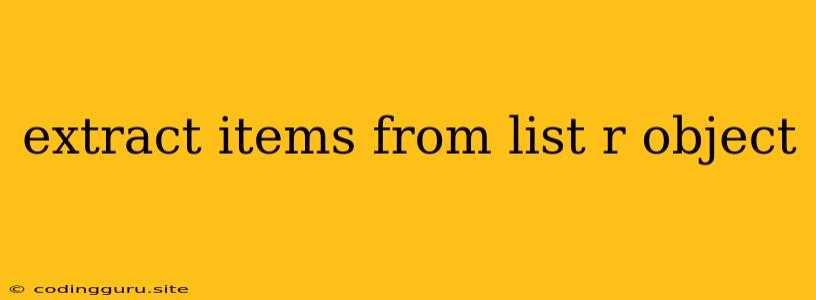Extracting Items from List Objects in R
Lists are a fundamental data structure in R that allow you to store a collection of diverse data types. This flexibility comes with the need to understand how to efficiently extract specific items from a list. This article will delve into various techniques for extracting items from list objects in R, covering both basic and more advanced scenarios.
Understanding List Structure
Before diving into extraction techniques, it's essential to grasp the concept of a list. A list in R can hold elements of different data types: numbers, characters, logical values, other lists, and even functions. These elements are accessed by their position or name, if assigned.
Extracting Items by Position
The simplest way to extract items from a list is by their numerical position. This is achieved using square brackets [] after the list name.
Example:
my_list <- list(10, "hello", TRUE, c(2, 4, 6))
# Extract the second item
second_item <- my_list[2]
# Print the extracted item
print(second_item) # Output: "hello"
This approach is straightforward for extracting single items. However, if you need to extract multiple items, you can use a vector of indices within the square brackets.
Example:
# Extract the first and third items
extracted_items <- my_list[c(1, 3)]
# Print the extracted items
print(extracted_items)
Extracting Items by Name
If you have named elements in your list, you can use the [[ operator along with the element's name.
Example:
my_named_list <- list(number = 15, text = "world", flag = FALSE)
# Extract the item named "text"
text_item <- my_named_list[["text"]]
# Print the extracted item
print(text_item) # Output: "world"
The [[ operator retrieves the value directly, while [] returns a sub-list if the element is itself a list.
Extracting Specific Elements Based on Conditions
You can extract items from a list based on logical conditions using the subset() function or by creating a logical vector.
Example:
my_list <- list(10, 5, 12, 7, 3)
# Extract elements greater than 8
filtered_list <- subset(my_list, my_list > 8)
# Print the filtered list
print(filtered_list) # Output: 10, 12
Alternatively, you can use a logical vector:
# Create a logical vector based on condition
condition <- my_list > 8
# Extract items based on the logical vector
extracted_elements <- my_list[condition]
# Print the extracted elements
print(extracted_elements)
Extracting Items from Nested Lists
Extracting items from nested lists requires a bit more finesse. You can use a combination of indices and names to access the desired element.
Example:
nested_list <- list(a = 1:3, b = list(x = 4, y = 5), c = "hello")
# Extract the value of "y" from the nested list "b"
y_value <- nested_list[["b"]][["y"]]
# Print the extracted value
print(y_value) # Output: 5
You can also use lapply to extract a specific element from multiple nested lists within a list.
Example:
nested_list <- list(list(x = 10, y = 20), list(x = 30, y = 40), list(x = 50, y = 60))
# Extract the "y" value from each nested list
extracted_y_values <- lapply(nested_list, function(x) x[["y"]])
# Print the extracted values
print(extracted_y_values) # Output: list(20, 40, 60)
Advanced Extraction Techniques
For more complex scenarios, R offers powerful functions like lapply, sapply, and purrr::map to manipulate and extract items from lists. These functions allow you to apply custom functions or operations to each element of a list, enabling efficient processing and data extraction.
Conclusion
Extracting items from a list in R is a common task that requires understanding the structure of lists and using the appropriate techniques. From simple indexing to conditional filtering and applying functions to nested lists, R provides a comprehensive set of tools for manipulating and extracting data from list objects. By mastering these techniques, you can efficiently work with list data structures and unlock the full potential of R for data analysis and manipulation.
